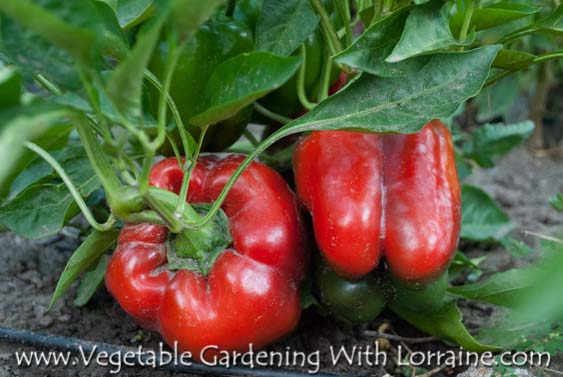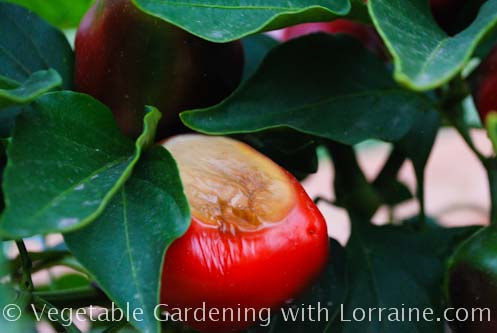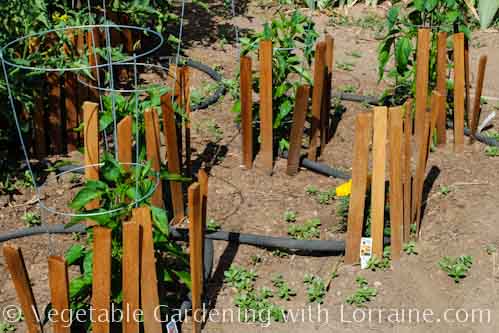- Home
- How to Grow Vegetables A-Z
- Growing Peppers
Growing Peppers:
A Lot of Flavor for Little Effort
 Growing Peppers
Growing PeppersThe biggest reason I love growing peppers is that they come in and endless variety of colors, sizes, shapes and most of all, flavors. I’m not just talking about how hot (or not) they are, but of distinctively, decidedly unique flavors. I’ve had a lot of fun experimenting over the years, because growing hot peppers, sweet peppers, chili peppers, bell peppers, pimento peppers, banana peppers (you get the idea...) is super easy, doesn’t take much space, and my peppers have never had a problem with pests or diseases.
Growing Peppers from Seed: Start Indoors
Unless you live in USDA Zone 9 or warmer, you’ll want to start growing peppers indoors under bright fluorescent lights about 8-10 weeks before your last frost date. Peppers are slow germinators (up to 3 weeks) and slow growers, and on top of that they hate being transplanted out into cold soil. So for the earliest harvest, start peppers indoors, and preferably on a heat mat.
Heat mats use very little power and will really speed up both germination and growth. When growing peppers from seed in cold climates, a heat mat can make the difference between a great harvest and no harvest at all. Just don't use a regular heating pad - even on low they get too hot and they are not safe for wet environments.
Because peppers are such slow-growers they are extremely sensitive to root shock, and any root damage will really set them back, delaying harvest. I start my peppers in individual 4" pots so that they can grow to a decent transplant size without having to be repotted along the way, and so that roots from more than one plant don’t get entangled and become damaged while separating. It is important to get the timing exactly right here - you want to roots to be just starting to touch the edges of the pot so that the soil holds together when you transplant them out, but not to where the roots have started to turn and circle in the pot (from which they never quite recover).
I plant 3 seeds ¼” deep in the same hole (insurance against poor germination), but then I cut off the smaller two at ground level when they’ve got two sets of true leaves. Don’t pull them out by the roots or you’ll damage the roots of the survivor.
Some people like to use peat pots and just plant the whole pot in the ground because they eventually decompose. But in my experience, peat pots take way too long to break down and restrict the free development of roots well after transplant.
I prefer to use either sturdy reusable plastic pots, or empty
toilet paper center tubes stood on end in a catbox-type tray. I remove the pot by pushing
the plants out of it from the bottom, or peeling off the toilet paper roll when
transplanting. The larger and least disturbed the roots, the
earlier and larger the harvest. If using toilet paper tubes, you also have to get the timing just right, because the moisture eventually causes the toilet paper core to unwind and sometimes they grow mold, as any cardboard does if it stays wet all the time.
Transplanting Peppers
Be sure to harden off your plants by setting them out in a sheltered spot for increasingly longer times each day for a good week before transplanting out. This lets them build stem strength in the breeze and adapt to the intensity of outdoor sun. By the time they get put in the ground they should be ready for a full day of sun and wind.
After planting them out, for an extra leg-up you can cover the babies with Reemay or other spun polyester to protect them at first, especially if it’s not yet in the 80s during the day. Even a bit of cold will set back their growth.
Just like their siblings the tomatoes, peppers can grow roots along submerged parts of the stem, so plant them deeper in the soil than they were in their containers. You can bury the stem up to their cotyledons, or “seed leaves” (those first two leaflike things that sprout out of the seed). This will make a stronger, healthier plant that will yield more.
Soil and Water Conditions for Growing Peppers
Peppers like lots of compost, good drainage, and a regular supply of water. Irregular dry/wet conditions will slow growth and delay harvest. We put our beds on a surface irrigation system that waters them a little every other day, and we get prolific yields.
After the soil has really warmed up I mulch my peppers with grass clippings or manured straw from our duck pen, which retains moisture, reduces weeds and adds a tiny bit of nitrogen. The most important benefit of mulch is keeping the ripening peppers off the ground, where they would otherwise become slug fodder.
Peppers will often get sunscald, or dying patches on the pepper fruits. This is caused by intense heat and direct sun on parts of the pepper for extended periods of time, which can happen if the plant loses a leaf, or a pepper outgrows the shade of the leaves above. During the height of summer when fruits are ripening, you can cover the plants with Reemay to prevent sunscald, or stick stakes intermittently in the ground around the plants to provide scattered shade as the sun moves overhead.
 Sunscald Damage on a Sunscald Damage on aRipened Red Pepper |
 One Way of Preventing One Way of PreventingSunscald on Peppers |
Diseases of Peppers
In Colorado where I live the summers are dry and hot, which makes the peppers happy and they are not bothered much by diseases. Where there is more humidity, growing peppers that are disease-free can be more challenging. Peppers are susceptible to many of the same diseases as other Solanacea family plants (the nightshades: tomatoes, eggplant, tobacco, potato). For this reason you should consider all these plants as the same when planning crop rotations.
The most common diseases of peppers are:
|
Virus-Caused Bacteria-Caused Other |
Fungus-Caused |
To see a photo gallery of some of these pepper diseases visit their board over at Pinterest.
Organic controls for pepper diseases are not very effective, and what I usually recommend is just pulling the affected plants and dumpstering them. Always wash hands and preferably change clothes before working again with healthy plants. Practice good crop rotation and garden cleanup. Read the article Preventing Plant Diseases.
Blossom end rot is not a biological disease, but is caused by irregular watering, which in turn makes it difficult for the plant to absorb calcium. While there is no cure for an affected pepper, you can prevent it from occurring to other peppers by providing consistent, regular watering.
Help share the skills and spread the joy
of organic, nutrient-dense vegetable gardening, and please...
~ Like us on Facebook ~
Thank you... and have fun in your garden!
Affiliate Disclaimer
This website contains affiliate links to a few quality products I can genuinely recommend. I am here to serve you, not to sell you, and I do not write reviews for income or recommend anything I would not use myself. If you make a purchase using an affiliate link here, I may earn a commission but this will not affect your price. My participation in these programs allows me to earn money that helps support this site. If you have comments, questions or concerns about the affiliate or advertising programs, please Contact Me.Contact Us Page



